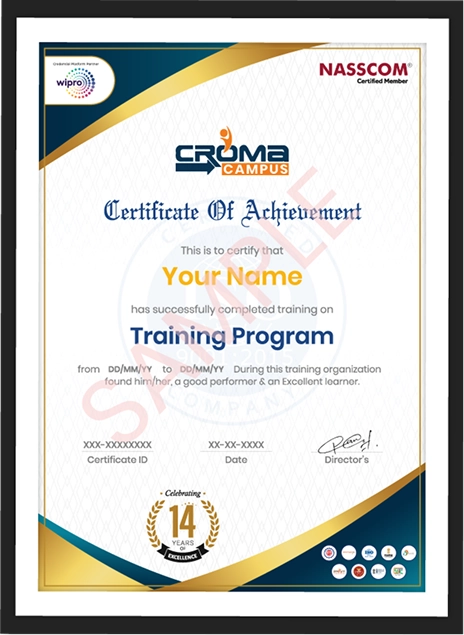Course Design By
Nasscom & Wipro
Comprehensive Learning: Gain an immersive understanding of data analysis with our expertly designed curriculum.
High-Quality Learning Materials: Access top-tier learning materials and resources that will refine your necessary skills.
Career Advancement: Our Data Analysis Course is designed to help you kick-start an exceptional career journey.
Practical Experience: Learn through real-life case studies and hands-on practice to thoroughly grasp the concepts.
Decision-Making Skills: Discover how enterprises utilize data in their business processes to make informed decisions.
Master Data Analysis Concepts and Principles: Our Data Analysis Course makes you an expert in data analysis concepts and principles.
Extract Meaningful Insights: Learn how to extract meaningful insights from data, such as hidden patterns, market trends, unknown correlations, and customer preferences.
Enhance Your Data Analysis Skills: Sharpen your data analysis skills and familiarize yourself with various data analytics terminologies.
Utilize Open-Source Data Analytics Tools: Familiarize yourself with open-source data analytics tools like R Studio and Spotfire.
Balanced Theoretical and Practical Knowledge: We offer an optimal distribution of theoretical and practical knowledge.
Advanced Concepts Mastery: Once you have mastered the fundamentals of the Data Analysis Course, youll learn more advanced concepts of R Studio, Tableau, Spotfire, and statistics.
Thriving IT and Business Hub: Ahmedabad is rapidly growing as an IT and business hub, attracting numerous companies that rely on data analytics for decision-making and strategy development.
High Demand for Skilled Professionals: There is a high demand for skilled data analysts in Ahmedabad, driven by the increasing adoption of data-driven approaches by businesses across various industries.
Competitive Salaries: Data analytics professionals in Ahmedabad enjoy competitive salaries, making it an attractive career choice for many.
Quality Education and Training Institutes: The city hosts several reputable institutes offering comprehensive data analytics training, ensuring high-quality education and industry-relevant skills.
Career Growth Opportunities: Completing data analytics training opens up numerous career growth opportunities, from entry-level positions to senior roles in diverse sectors such as finance, healthcare, retail, and IT.
Access to Industry Experts: Training programs in Ahmedabad often feature industry experts and experienced professionals as instructors, providing valuable insights and real-world knowledge.
Networking and Collaboration: Ahmedabad offers a vibrant community of data professionals, providing ample networking and collaboration opportunities through events, seminars, and workshops.
Technological Advancements: The city's focus on technological advancements and innovation further boosts the importance of data analytics, as companies seek to leverage data for competitive advantage.
Practical Exposure: Many training programs emphasize hands-on learning and real-life projects, ensuring that participants gain practical experience and are job-ready.
Diverse Job Roles: Data analytics training in Ahmedabad prepares professionals for a variety of roles, including data engineer, data scientist, data architect, and business intelligence analyst, catering to the diverse needs of the job market.
Comprehensive Knowledge of Data Analytics: You should be proficient in all data analytics concepts and associated skills.
Familiarity with Key Terminologies: Understand key data analytics terminologies such as acquisition, manipulation, evaluation, and experimentation.
Programming Proficiency: Implement basic R programming and Tableau programming, and get acquainted with open-source data analytics tools.
Advanced Training Opportunities: Engage in advanced training in fields like advanced analytics, R Studio, Tableau, Spotfire, and statistics.
Industry Preparedness: Our Data Analytics Course, through projects, webinars, and assignments, will prepare you for the industry, helping you secure a lucrative position at a leading company.
Establish yourself as a certified data analytics specialist now.
Leading companies, including Google, Intuit, Cisco Systems, Facebook, Apple, Capital, Maruti, and others, are on the lookout for talent like yours.
Our Data Analytics Course offers dedicated interview preparation sessions to help you succeed in job interviews.
Prepare yourself to overcome any obstacles in your professional journey.
Get noticed by recruiters and secure a job quickly.
Our experts provide crucial interview tips to support your job search.
Boost your value in the competitive job landscape.
Globally accepted, this certification allows you to pursue opportunities abroad.
Acquire the expertise needed to pass any certification exam with confidence.
we train you to get hired.

By registering here, I agree to Croma Campus Terms & Conditions and Privacy Policy
+ More Lessons
Course Design By

Nasscom & Wipro
Course Offered By

Croma Campus

Stories
success
inspiration


career upgrad


career upgrad


career upgrad


career upgrad
12-Jul-2025*
14-Jul-2025*
16-Jul-2025*
12-Jul-2025*
14-Jul-2025*
16-Jul-2025*

You will get certificate after
completion of program

You will get certificate after
completion of program

You will get certificate after
completion of program
in Collaboration with






Empowering Learning Through Real Experiences and Innovation

we train you to get hired.

Phone (For Voice Call):
+91-971 152 6942WhatsApp (For Call & Chat):
+91-971 152 6942Get a peek through the entire curriculum designed that ensures Placement Guidance
Course Design By


Course Offered By

Ready to streamline Your Process? Submit Your batch request today!
It offers comprehensive knowledge, expert-led sessions, and increased job opportunit
It provides hands-on projects, interview preparation, and industry insights.
You can pursue roles like data analyst, data engineer, data scientist, and data architect.
Yes, it covers fundamental concepts and advances to complex topics.
Yes, the globally recognized certification opens up international opportunities.

FOR QUERIES, FEEDBACK OR ASSISTANCE
Best of support with us
For Voice Call
+91-971 152 6942For Whatsapp Call & Chat
+91-9711526942